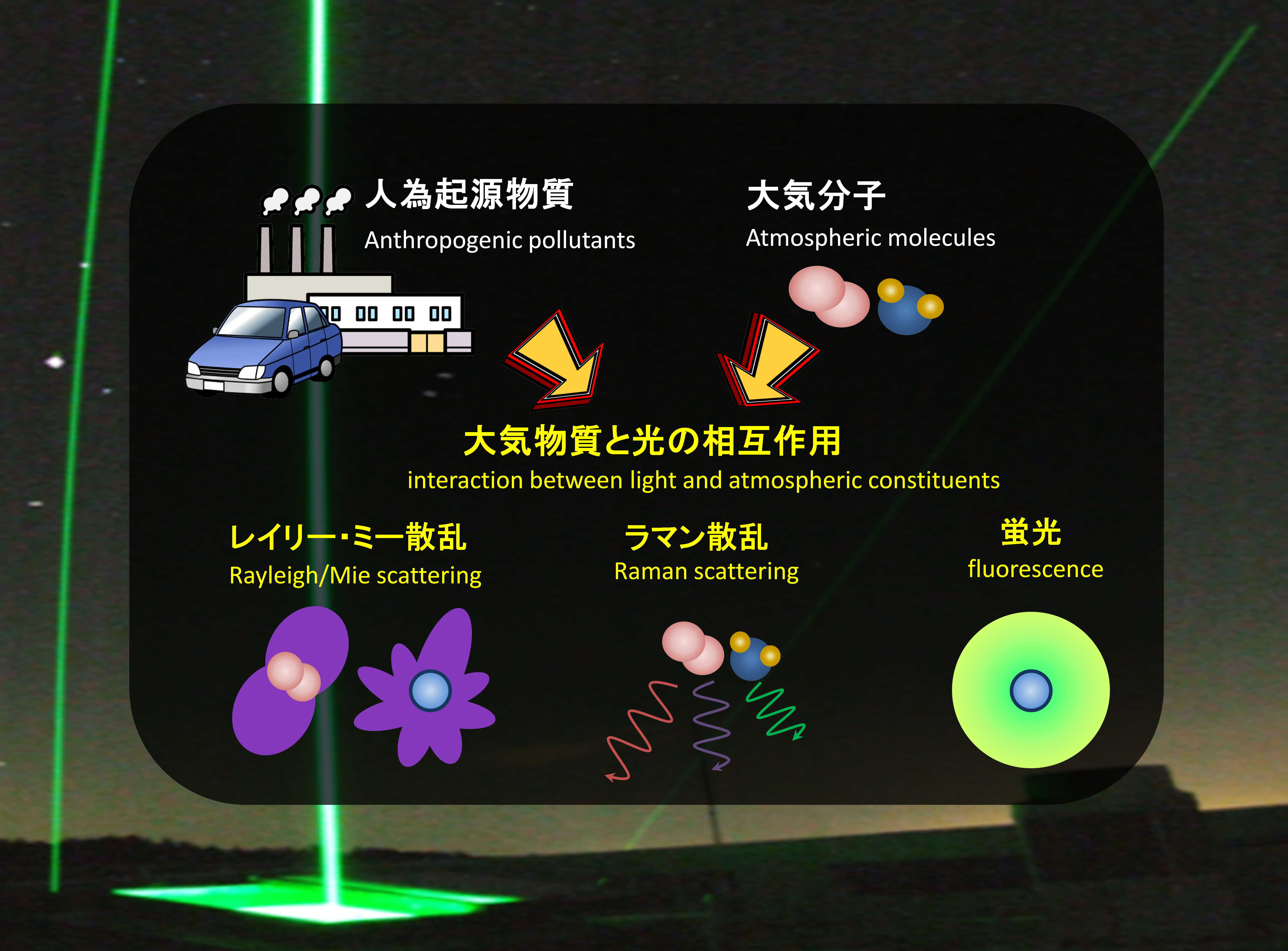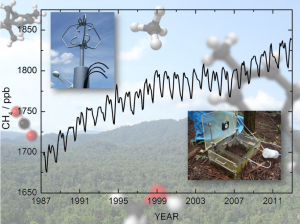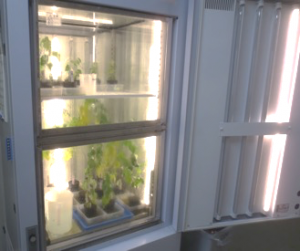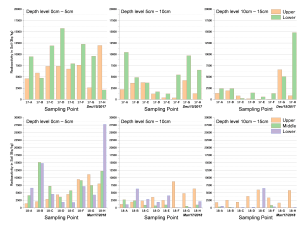2021 Activity Report for Mission 1: Environmental Diagnosis and Regulation of Circulatory Function
Updated: 2022/06/01
Research1:Biosphere−Atmosphere Exchange of Trace Molecules
Principal Investigator (PI): K. Takahashi (RISH, Kyoto University)
Research collaborator(s): Y. Kosugi (Graduate School of Agriculture, Kyoto University), A. Sakabe (Hakubi Center, Kyoto University), M. Itoh (Univ. Hyogo), H. Iwata (Shinshu Univ.)
We study carbon dynamics from the ecosystem scale to the plot scale in forest environments through in-situ measurements of trace gas fluxes based on micrometeorological methods and automated closed-chamber techniques.
Publication
- A. Sakabe, K. Takahashi, W. Azuma, M. Itoh, M. Tateishi, and Y. Kosugi, Seasonal Variation and Controlling Factors of Stem Methane Emissions from Alnus japonica in a Riparian Wetland of a Temperate Forest, J. Geophys. Res. – Biogeosci. 126, e2021JG006326, doi:10.1029/2021JG006326, 2021.
Research 2 :Analysis of plant metabolites in the rhizosphere
Principal Investigator (PI): Akifumi Sugiyama (RISH, Kyoto University)
Research collaborator(s): Hisabumi Takase(Graduate School of Agriculture and Life Sciences, The University of Tokyo), Yuichi Aoki (Graduate School of Agriculture and Life Sciences, The University of Tokyo)
The aim of this research is to elucidate the molecular mechanism of plant microbe interaction in the rhizosphere. We analyze transporter genes and metabolites which are involved in the plant microbe interactions. This year we revealed α–tomatine is secreted from tomato roots and functions to modulate tomato rhizosphere bacterial communities.
Figure. Secretion of α–tomatine into the rhizosphere of tomato
Publication
- M. Nakayasu, K. Ohno, K. Takamatsu, Y. Aoki, S. Yamazaki, H. Takase, T. Shoji, K. Yazaki, A. Sugiyama.Tomato roots secrete tomatine to modulate the bacterial assemblage of the rhizosphere. Plant Physiology 186:270–284. 2021
Research 3: MU radar imaging observations of atmospheric structure in the troposphere
Principal Investigator (PI): Hiroyuki Hashiguchi (RISH, Kyoto University)
Research collaborators: Lakshmi Kantha・Abhiram Doddi(University of Colorado, USA)、Hubert Luce(Université de Toulon, France)
Range imaging was implemented in the MU radar observations during the Shigaraki UAV Radar Experiment (ShUREX) campaigns in the spring/summers of 2015, 2016, and 2017. The Capon backscatter images revealed a variety of atmospheric structures in the moist troposphere in details. Figure shows the time-height cross-section of echo intensities obtained by the MU radar range imaging. It can be seen that Kelvin-Helmholtz (KH) billows exist at an altitude of about 5 km in 14:30-14:50.
Time-height cross-section of echo intensities obtained by the MU radar [Kantha et al., 2019]
Publications
- H. Hashiguchi, Phased Array Atmospheric Radar, Invited talk, International E-Conference on Advances in Information Technology and Research, Online, May 31-June 1, 2021.
- Hubert Luce, Abhiram Doddi, Dale Lawrence, Tyler Mixa, Masanori Yabuki, Koji Nishimura, and Hiroyuki Hashiguchi, Characterization of atmospheric turbulence at Syowa station from Datahawk UAVs, stratospheric balloons and the PANSY radar, Invited talk, The 12th Symposium on Polar Science, Online, November 15-18, 2021.
Research 4: Alteration of cell shape in primary tissue during gravitropism
Principal Investigator (PI): Kei’ichi Baba (RISH, Kyoto University)
With a view to constructing extraterrestrial forests that contribute to humankind’s long-term stay in space, tree responses under several artificial environments, such as microgravity, shortened annual cycle and so on, are investigated. We cultivate poplar, which is a model organism of woody plant, and investigate its growth, morphogenesis, and the physiological response under an artificial environment. Microgravity condition is performed by mounting a tree on a clinostat. The shortened annual cycle cultivation is a system that shorten the annual cycle to 5 months while maintaining the annual ring formation ability of poplar by controlling the environment using growth chambers.
Publications, etc.
- The 85th Annual Meeting of the Botanical Society of Japan, Hachioji (Online), Japan, Sep 19-21, 2021
- 72nd Annual Meeting of the Japan Wood Research Society, Nagoya (Online), Japan, Mar 15-17, 2022
Research 5:Collaborative studies in Fukushima since the Great East Japan Earthquake
Principal Investigator (PI): Yoshikatsu Ueda (RISH, Kyoto University)
Research collaborator(s): Akifumi Sugiyama (RISH, Kyoto University) ,Naoto Nihei (Graduate School of Agricultural and Life Sciences, The University of Tokyo, Rattanaporn Norarat (Rajamangala University of Technology Lanna, Chiang Rai, Thailand), Minoru Tanigaki (Institute for Integrated Radiation and Nuclear Science, Kyoto University)
Using KURAMA-II (Kyoto University Radiation Measurement System), we investigated the environmental radioactivity after decontamination in the rice fields of Iitate Village, Fukushima Prefecture. We compared the cross-correlation between the measurement results of KURAMA-II and those of actual soil sampling to confirm the measurement error, especially in the sloping area around the rice field. The results showed an excellent agreement between the soil sample of 5 cm surface layer even in slope.
Radiation density of soil samples by depth and location (top: 2017, bottom: 2018)
Publications, etc.
- Y. Ueda, N. Nihei, R. Norarat, M. Tanigaki, Correlation between Radiation Measurement on the Field Slopes using KURAMA-II(Kyoto University RAdiation MApping system) and Environmental Radioactivity in the Soil Depth Direction, SPRINGER PROCEEDINGS in Physics, INCREASE and 6th ARN, accepted 2021
- Y. Ueda, N. Nihei, R. Norarat, M. Tanigaki, Correlation between Radiation Measurement on the Field Slopes using KURAMA-II (Kyoto University RAdiation MApping system) and Environmental Radioactivity in the Soil Depth Direction, LAPAN – Kyoto University International Symposium for Equatorial Atmosphere EAR 20th Anniversary 20-21 September 2021
Research 6: Observations of atmospheric minor constituents using lidar techniques
Principal Investigator (PI): Masanori Yabuki (RISH, Kyoto University)
Atmospheric lidar is a powerful tool for monitoring atmospheric constituents, which are key parameters for understanding the mechanisms underlying environmental changes and localized extreme weather events. In FY2021, the new calibration method was developed for a temperature Raman lidar. We consrtucted a compact fluorescence lidar for bio-particle detection based on a multi-wavelength ultraviolet (UV) detection system. Aerosol and cloud properties in Polar region were investigated by using the longtime monitoring data of a micro-pulse lidar.

Publication
- Mori, T., Y. Kondo, S. Ohata, K. Goto-Azuma, K. Fukuda, Y. Ogawa-Tsukagawa, N. Moteki, A. Yoshida, M. Koike, P. R. Sinha, N. Oshima, H. Matsui, Y. Tobo, M. Yabuki (2021) W. Aas, Seasonal Variation of Wet Deposition of Black Carbon at Ny-Ålesund, Svalbard, J. Geophys. Res.: Atmosphere, 126, 12, doi.org/10.1029/2020JD034110, 2021.
Research 7: Breeding of gramineous plants toward revegetation of deteriorated grass field and production of biomass energy
Principal Investigator (PI): Toshiaki Umezawa (RISH, Kyoto University)
Research collaborator(s): Yuki Tobimatsu, Takuji Miyamoto, Rie Takada, Masaomi Yamamura (RISH, Kyoto University), Satoshi Konishi (IAE, Kyoto University), Masahiro Sakamoto (GSA, Kyoto University), Satya Nugroho (LIPI), Safendrri Komara Ragamustari (LIPI)
Appropriate management and revegetation of deteriorated grasslands formed after natural forest logging in Southeast Asia are global issues. In order to address this issue, we have been conducting researches aimed at revegetation of deteriorated grasslands and production of biomass energy. In this fiscal year, we are conducting the breeding of biomass plants suitable for carbon sequestration combining photovoltaic power generation and biomass production. In particular, we are promoting the breeding of high-productivity grass biomass plants with high carbon content.
Publications, etc.
- Masaomi Yamamura, Takuji Miyamoto, Rie Takada, Dwi Widyajayantie, Vincentia Esti Windiastri, Satya Nugroho, and Toshiaki Umezawa, A Microscale Protocol for Alkaline Nitrobenzene Oxidation of Lignins Using a Readily Available Reactor, Lignin, 2, 19-24, 2021.








